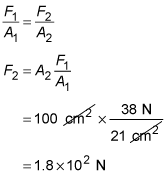Using physics, you can apply Pascal's Principle to determine how hydraulic systems function. For example, you can calculate how the size of a piston affects the pressure of another piston in the same system.
Here are some practice questions that you can try.
Practice questions
In a hydraulic system, a piston with a cross-sectional area of 21 square centimeters pushes on an incompressible liquid with a force of 38 newtons. The far end of the hydraulic pipe connects to a second piston with a cross-sectional surface area of 100 square centimeters. What is the force on the second piston?
Consider a hydraulic system with two pistons. Piston 1 applies a force F1 over area A1 and piston 2 applies a force F2 over area A2.
If you double the force applied by piston 1 and reduce the area of piston 2 by a factor of 3, what is the new force

in terms of the original force F2?
A piston that is part of a hydraulic system has a surface area of 0.025 square meters. The hydraulic fluid pushes on the piston with a pressure of 20,000 pascals. What pressure pushes on another piston in the same system?
Answers
The following are the answers to the practice questions:
1.

Pascal's principle gives

In this case, you know that

Solve the equation for

and insert the given values to find the force on the second piston:

-

Apply Pascal's principle to the new system (in other words, apply it after F1 is doubled and A2 is reduced by a factor of 3). Using primes to indicate the new quantities, you have

You know that

where the unprimed quantities are the original quantities. Use these equations in the previous equation and solve for

20,000 Pa
According to Pascal's principle, the change in pressure in an enclosed system is the same throughout the system. Therefore, the pressure on any piston in the system is the same: 20,000 pascals.

